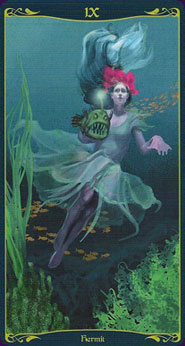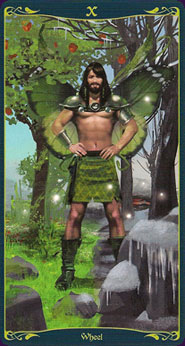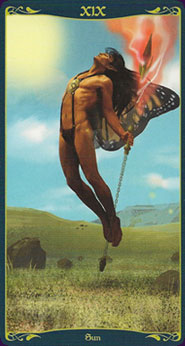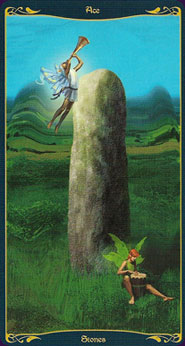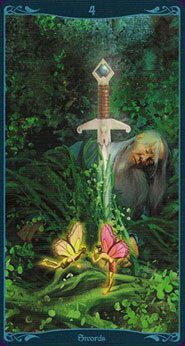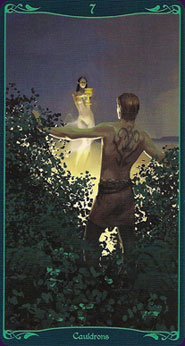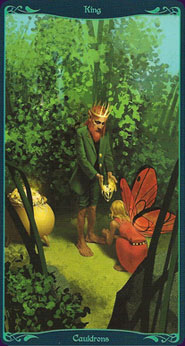Tarot of the Celtic Fairies Deck Review
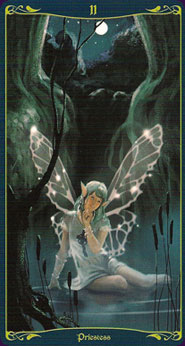
Creators: Mark McElroy, Eldar Minibaev
Publisher: Lo Scarabeo 2010
The Tarot of Celtic Fairies is a set of fey wisdom and guidance, with 78 cards and a guidebook written by Mark McElroy. "Journey to a hauntingly beautiful fairie land steeped in Celtic lore. Vivid, luminescent scenes vibrate with significant detail, deep meaning, and sheer beauty."
Retailers
See Price at Amazon.comTarot of the Celtic Fairies Review by Lillie
The Tarot of the Celtic Fairies by Lo Scarabeo is an unusual deck that takes the folklore of the Celtic countries of western Europe and applies the myths, legends and characters of those stories to the archetypes of the tarot deck. The kit contains a 160 page book by Mark McElroy containing numerous illustrations in full colour and a 78 card, fully illustrated tarot deck featuring the art work of Eldar Minibaev. Both of these are housed together in a neat and sturdy box with a hinged lid that combines premium protection of the contents with ease of access. Within this elegant package there is not only a treasure trove of fairy lore combined with a unique and beautiful tarot deck but also a fascinating insight into the process of creation and the authors personal journey that brought these two traditions together.
At first glance the deck appears traditional enough, it is structured much as one would expect from a modern tarot deck. There are 22 Majors Arcana cards, all carrying their familiar numbers and names, Strength is VIII and Justice XI as is common with decks that follow the Rider Waite tradition. The Minor Arcana is divided into four suits numbered from 1 to 10 with four court cards each. Three of the suit names have been modified slightly, Wands have become Spears, Cups are now Cauldrons and Pentacles are Stones but this is a small change and easily interpreted by anyone familiar with the usual suit names. Each card is fully illustrated, the minors no less than the majors, the image surrounded by a thin, elegant border against a dark, forest green background, and the titles, numbers and borders are all colour coded to their suit. Each card also features a non reversible back design that combines aspects of traditional Celtic art in an elegant and modern way. Unusually for a deck from Lo Scarabeo the titles are in English only, although the numbering is the expected Roman numerals for the Majors and Arabic for the Minors. The cards are, as always with decks from Lo Scarabeo, printed on good quality card stock and, despite the dark backgrounds, a number of heavy shuffles and much handling did not cause even minor scuffing upon their surface.
Beyond the basic structure of the deck, however, the Tarot of Celtic Fairies subverts the traditions of the tarot and confounds the expectations of the reader. In its depictions and interpretations of tarot meaning and iconography this is a deck that will both confront and challenge the preconceptions of anyone who wishes to work with it, taking the prospective reader upon a journey both into the depths of fairy lore and into the potential breadth of meaning that lies within the tarot tradition. The atypical nature of this deck is apparent as soon as one begins to look at the images upon the cards. For a person familiar with any of the main tarot traditions these cards will hold many surprises, gone are the majority of the expected and traditional symbols, there are no scales upon Justice, there is no wheel upon The Wheel of Fortune, no cliff or dog upon The Fool. The Minors likewise have been shorn of much of what would be expected. The numbered cards do not show the suit signifier in the correct number, sometimes they do not show it at all. The much used Rider Waite images have, for the most part been abandoned and gone is the boat upon the 6 of Swords, the pierced heart upon the 3 and the man bowed beneath his burden on the 10 of Wands. Instead the creators of this deck have chosen to delve into fairy lore and into the legends and traditions of the ancient Celts, finding parallels between the events and peoples in those stories and the meaning of each card rather than relying upon its typical iconograpy. While this may be difficult for some readers it will be a challenge and a pleasure for others as it presents the cards in a new and novel way, bypassing the learned meanings and allowing fresh insights into familiar cards.
The Major Arcana generally makes a connection between the inherent meaning of a card and a particular personage in the Celtic pantheon such as Onagh, Queen of the Fairies as the Empress or the Welsh Gwn Ap Nudd as the Devil. Likewise The Dagda, harp in hand, is the personification of the Emperor; as the music of The Dagda's harp regulates the turning of the seasons so does this card describe the power and control indicated by The Emperor. Other cards are not symbolised by personages, but instead by types of creature, the meaning of the card illustrated by their traditional behaviour. In this way the industrious but mischievous leprechaun represents The Magician in his aspects of both trickster and mage. In the same way Death is represented by the deadly Banshee and the Hierophant by the Druid Priest that mediates between mankind and the powers of the fairy realm.
The suits of the Minor Arcana have been renamed to follow the pattern of the four sacred treasures of Celtic mythology, the unbeatable Spear of Lugh, the inexhaustible Cauldron of The Dagda, the Sword of Nuadda that always struck true and the Stone of Destiny that would cry out when touched by the rightful King. The Tarot of the Celtic Fairies matches these sacred objects to the four suits of the tarot and then, with a combination of numerology and a deep understanding of the usual Waite Smith illustrations presents the reader with images and ideas that are often radically new while still remaining true to the spirit of the card. Unlike the Majors the Minor Arcana does not focus upon personages or personalities, but instead presents us with scenes drawn from fairy lore, each illustrating a different aspect of both fairy and of tarot. In this way the 6 of Cauldrons portrays a dish of milk being left upon a doorstep as an offering to the fairy folk, the 5 of Stones depicts the disturbing image of the changeling as a metaphor of loss and the 8 of Swords shows not only a woman trapped within a fairy ring but also a man bearing the rowan branch that will free her.
The Court cards, whilst bearing their normal titles of Page, Knight, Queen and King are in fact the most atypical feature in this unusual deck. Here none of the cards are portrayed as might be expected, only one of the knights is mounted upon a horse and frequently the person for whom the card is titled appears to be a subsidiary character on their own card. This is illustrated by the Queen of Swords; this images shows someone playing a drum and singing, above and to the side of them flies a small fairy woman holding a long needle, this is the Loireag who pricks poor sempstresses and singers with her wicked needle. It is this creature, the Loireag, rather than the larger figure who is the Queen of Swords, in this case imaged as the critic of the talents of others. Likewise the King of Spears is the small and rather unimpressive figure of Fear Dearc, a gnome like creature who knocks upon the door and asks to warm himself before your fire. Unfortunately this question has no good reply, for if the answer is 'No' he will use his fairy powers to revenge himself, but if instead the reply is 'Yes' he will steal from you and cause untold amounts of mischief. A radical and unusual interpretation of this King's fiery nature, but one that for all its unexpectedness has something important and different to say.
A curious feature of this deck is its portrayal of the sexes, in almost all cases the male figures seem more fully realised than the female, they are more immediate, more real, often placed more prominently upon the card. A perfect illustration of this is the Queen of Cauldrons. In this extraordinary card there are two figures, one male, one female. The male faces the viewer, the female, the Queen for whom the card is named faces away. Furthermore many of the female figures are portrayed as either distant, ethereal and untouchable or as dangerous femme fatales masquerading behind a mask of beauty. In this way the beautiful woman in the 7 of Cauldrons is in fact a Watershee, a temptress that will lure unsuspecting men to their doom. Another unusual feature of this deck is the way that it often portrays the opposite of the cards usual meaning, focusing upon the negative aspect of the card. In this way Temperance is shown as a very intemperate Leprechaun, as drunk as a lord, clinging to a bucking goat, spilling his wine and ale. Darker illustrations of these reversals of meaning comes in both The Star and The Lovers. Usually an image of hope The Star in the Celtic Fairies shows a Sheerie, an unpleasant creature that tricks men through false hope, leading them deep into the swamps to their deaths. The Lovers shows the Leannan Sidhe and Gan Canach, male and female creatures that use the desire for love to destroy unsuspecting men; in the case if the Leannan Sidhe we have again an apparently beautiful female who uses her sexuality to deceive men and drain them of their lives and vitality.
The book that accompanies this kit reveals Mark McElroys profound understanding of the tarot as much as the images showcase Eldar Minibaev's art. Not only does the book explain and illuminate this deck but it also provides important insight on the reading of the Tarot in general, in particular the short portion of the book that deals with the numerological reading of the Minors could be applied to any deck, not just this one. Furthermore this book reveals important information about the creative process that resulted in this deck, along with pictures and vignettes taken from the actual cards we are also given glimpses of earlier, alternate versions, preliminary sketches and illustrations of the thought process that goes into making a tarot deck. However the main part of the book is taken up with the understanding and interpretation of the deck that we have, rather than the deck we might have had. In this portion of the work the book goes through the deck card by card, each illustrated in full colour. For each one there are keywords given and then a section called 'Creator's Commentary' where McElroy elucidates his choices regarding these images and explains the meaning behind them, linking the image both to the fairy lore they are based upon and also to other tarot traditions, primarily that of the Rider Waite deck. Following this there are a few paragraphs, again illustrated in full colour, in which certain important symbols are picked out and explained. Lastly there is a section that explains the meaning of the card in the context of a reading and asks illuminating questions that may be raised by its presence in a spread. Finally, at the end of the book there is a section that includes a number of different spreads that may be used with this deck, ranging from the simple to the complex, along with tips on approaching and connecting with the cards.
This deck is so different, so iconoclastic, so rooted in the intricate stories and traditions of Fairy that it is difficult to say how well the deck might be understood without the aid of this book. However, in my copy there was not only the 160 page book but also the small booklet that would accompany the deck if it was sold alone. The meanings contained in this are, of necessity, brief, but although they do not, indeed cannot, contain the depth and breadth of the book they nevertheless give enough information on the fairy tradition behind each card to allow a reader to do their own research and discover more for themselves. However, without a doubt the owner of the kit would be better informed and more prepared for the challenges raised by this deck. Of course some readers would need none of these things, Minibaev's lovely pictures have a wealth of detail that could be used intuitively regardless of the meanings or traditions outlined in the book.
This is not a deck that will be for everyone, it will not be a deck for those who wants something that is quick and easy to understand, a deck that complies with what they expect and copies what they have seen before. However it will appeal to those who have a love of the old Celtic legends and fairy lore and those who are willing to immerse themselves in the language of this deck, who are keen to challenge themselves and see the old familiar cards illustrated in a new and unusual way.
Tarot of the Celtic Fairies Review by Spacegoat
Great art, a fantastic sense of humour (the greedy fairy enjoying partially digested food inside a humanís stomach on the nine of cups), rich colours Ė but the cards have been so poorly laminated that, having owned the cards for only three weeks, many of the cardsí images are already exhibiting signs of wear Ė and they havenít been shuffled even once.
Oddly, two other decks released by Lo Scarabeo at the same time as this one havenít shown signs of wear at all (2012 Tarot of Ascension and the Elemental Tarot).
This isnít the only deck too fragile to be shuffled that I have in my collection. The truth is, I havenít shuffled a pack of tarot cards since 1995, when I realised that doing so was resulting in Ďchipsí on the laminate, spoiling the images.
It seems that for years, tarot card publishers (including US Games, Llewellyn, AGMuller, Piatnik, Lo Scarabeo etc) have tried various laminates to protect the images on the cards, to give them a longer life. Some laminates are better than others. Sadly, even on cards that have never been shuffled, laminate still chips off.
Iím not sure that Lo Scarabeo have been using any laminate at all, for some time. (Not since their ĎTarot díArteí series in the late 1980ís, and a one-off glossy laminate on their ĎWitchy Tarotí from 2003). Perhaps itís the quality of the ink, perhaps itís the cardstock, but not all their decks are as fragile as this one.
Anyway, I hope they find a solution to this. Letís face it Ė tarots are not cheap! In the UK, for the last year, the price for a Lo Scarabeo deck has been hiked up to just under £20. Surely we as punters deserve better quality cardstock / ink / laminate Ė whatever it takes, to keep the cardsí images on the cards themselves - where they belong.
Gripe over! This is a magnificent deck. Trouble has been taken to source the names of fairies from history, and create fabulous works of art with them. Lo Scarabeo have sometimes mismanaged their minor arcanas, cards often bearing images that have little or nothing to do with the traditional meanings. In this deck however, this has not happened. Most of the minors here bear images that express the traditional interpretations Ė and do so in surprising and sometimes shockingly original ways. (Itís not true to say that 100% of the minors are traditional here, but the deck is so good that this can be forgiven).
The back of the cards bear an elegant celtic knot, tying two faces who gaze at each other. Itís one of the best card-backs that Lo Scarabeo have ever created.
Complete Details of Tarot of the Celtic Fairies
Creators: Mark McElroy, Eldar MinibaevPublisher: Lo Scarabeo 2010
Deck Type: Tarot Deck
Cards: 78
Major Arcana: 22
Minor Arcana: 56
Card Size: 2.60 x 4.72 in. = 6.60cm x 12.00cm
Card Language: Spanish, Italian, German, French, English, Dutch
Companion Material: Little white booklet by Mark McElroy.
Rating: 14/20 or
Similar Decks to Tarot of the Celtic Fairies
Theme: Celtic, FairyCreator: Bright Idea Deck, Lo Scarabeo Tarot, Mona Lisa Tarot, Tarot of the Elves by Mark McElroy
< Previous Deck · Back to Top · Next Deck >
Home > Tarot Reviews > Tarot of the Celtic Fairies Review

